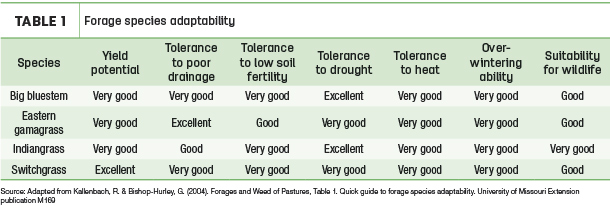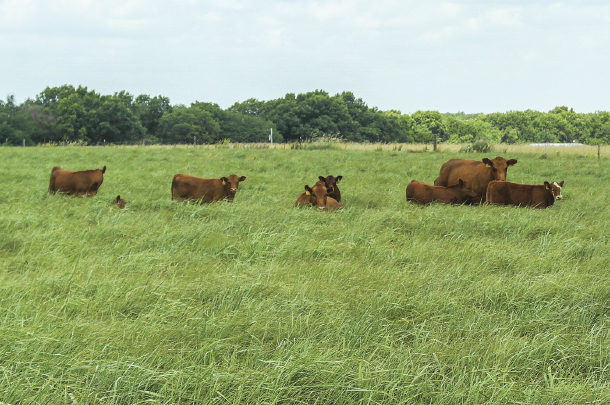Native warm-season grasses (NWSG) are notoriously slow to establish. The adage is: The first year it sleeps, the second year it creeps, and the third year it leaps. Warm-season grasses are most productive during summer months when temperatures range from 85ºF to 95ºF. Many of these are native plants which grew on prairies before the land was cultivated. A few of the NWSG include big bluestem, indiangrass, switchgrass and eastern gamagrass.
These deep-rooted plants are more drought-tolerant and more efficient than cool-season grasses at converting carbon dioxide, water and sunlight into carbohydrates for plant growth, especially when temperatures are high. Cool-season grasses (e.g., tall fescue, smooth bromegrass, orchardgrass) grow best in spring and autumn when temperatures are between 65ºF and 75ºF. A grazing system incorporating both cool- and warm-season grasses will provide a more consistent supply of forage during the growing season.
Native warm-season grasses are also beneficial to wildlife. They are bunch grasses which leave open “trafficways” for small game. The upright growth pattern and residual grazing or harvest height provide cover for animals to move without being detected by predators.
Deciding where to plant NWSG is the first step. Maintaining a mixture of cool- and warm-season grasses in one pasture or hay field is possible, but care must be taken to avoid giving one a competitive edge. When they are grown together, particular attention must be given to grazing or harvest height and fertility management, especially the timing of nitrogen fertilizer applications. Managing these two types of grass in separate fields is less complicated.
Controlling competition from other plants is critical for successful NWSG establishment. A minimum of two herbicide applications is recommended when renovating an established cool-season grass sod. It is difficult to eliminate all existing plants with a single herbicide application and, once the sod is killed, weed seeds which had been suppressed by the sod will have an opportunity to germinate. Using the spray-smother-spray method is an effective technique for sod renovation.
When using this method, spray the sod with a non-selective herbicide in spring. Plant an annual crop like pearl millet or sorghum-sudangrass as a smother crop. At the end of the growing season, apply herbicide if any escaped grasses or other weeds are present. A winter annual (e.g., cereal rye, triticale, wheat) can be planted if fall and early spring forage is needed. The following spring, spray the area two to three weeks prior to planting to reduce competition from plants with established root systems. Always read and follow label directions when applying herbicides.
Select NWSG species which are well suited for the site where they will be grown and for the management system where they will be used. Eastern gamagrass has excellent tolerance to poor drainage. Big bluestem and indiangrass have excellent tolerance to drought. Switchgrass and eastern gamagrass will begin growing earlier in the spring than either big bluestem or indiangrass. Table 1 contains information about species adaptability, or check with your local extension specialist for more information.

Plant NWSG when soil temperatures reach 60ºF to 65ºF. Some NWSG seeds are fluffy with long awns. The most effective way to achieve good seed-to-soil contact is to plant seed which has been cleaned to remove the awns or use a no-till drill with NWSG boxes. Most NWSG should be planted no deeper than a quarter-inch, so a firm seedbed is crucial. The seed of eastern gamagrass is much larger and should be planted at a depth of 1 inch using a corn planter. Planting rates are given in pounds of pure live seed (PLS) per acre. The percent PLS will be stated on the seed tag. Calculate the pounds of seed to be planted based on the PLS, and calibrate the drill or planter accordingly.
Controlling competition from weeds is critical during the establishment year. Prevent weeds from growing taller than the seedlings to ensure they receive adequate sunlight. Some herbicides cannot be applied until the NWSG seedlings reach a minimum height, making it necessary to mechanically remove weeds. Take care not to clip the seedlings shorter than 8 inches, and remove the thatch if it impedes light penetration into the canopy.
Native warm-season grasses can be productive in fields with low soil fertility; however, moderate phosphorus and potassium levels and a soil pH above 5.5 will increase the odds of successful stand establishment by improving seedling vigor. Do not apply nitrogen fertilizer at establishment. Seedlings are slow to establish, and nitrogen fertilizer increases weed competition.
During the establishment year, the stand should not be grazed or harvested for hay. By the second growing season, well-established stands can be grazed lightly. Graze early in the season and avoid grazing the plants below 8 inches in height. Do not graze when soil conditions are wet.
Three years is a long time to wait for a forage crop to establish. But with diligent weed control before establishment and during the first year of growth, prudent fertility management and maintaining adequate residual plant height, NWSG stands can be utilized the year after planting.









